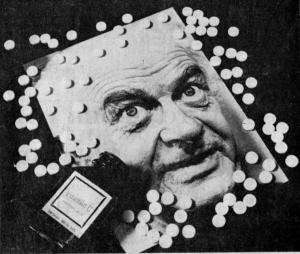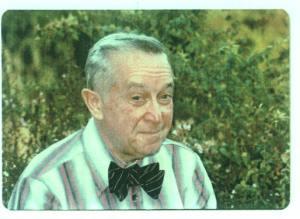
Detail from “The Perils of Pauling”, National Observer, November 27, 1971.
[Part 1 of 4]
Growing up in the United States, many children today are told to drink plenty of orange juice to get their vitamin C, in part to avoid getting a cold. And indeed, vitamin C is now widely accepted as an important nutrient. Its antioxidant properties are valuable to cellular health and can protect against heart disease as well as the genetic damage that can lead to cancer and other dysfunctions. It aids the body’s production of collagen and other connective tissues, and is important for optimal healing from injury. It is also implicated in optimal neurotransmission (brain function), and stimulates the production of white blood cells important for immune health. This basic component of healthy living has been repeated so many times on television shows like “Sesame Street,” or in the classroom, or at home around the dinner table, that American children grow up recognizing vitamin C’s importance as an obvious fact of life.
Perhaps surprisingly then, there is still little consensus in the medical community as to the ability of Vitamin C to significantly reduce the incidence, duration, or severity of the common cold. For Linus Pauling in 1971, it seemed so clear that Vitamin C was critical to human health that he felt compelled to publish his best-selling book, Vitamin C and the Common Cold, feeling that to withhold such simple and valuable information for the public’s general well-being would be negligent. His work sparked a vitamin C craze in America: after the book’s publication, consumption of vitamin C increased so much that bulk prices nearly tripled. The public certainly believed Pauling. Professional physicians, on the other hand, were highly critical.
While the full benefits of vitamin C are better known now than was the case in Pauling’s day, even in the 1970s no one argued against the vitamin’s fundamental importance. The real argument that emerged was about how much Vitamin C was enough, and why.
Oranges and other fruits and vegetables were known to prevent scurvy from at least 1753, when British naval physician James Lind reported on its effectiveness in treating this disease of nutritional deficiency. Vitamin C was first isolated in the early 1930s by Albert Szent-Györgyi, William Waugh, and Charles Glen King, and produced in the lab shortly after by Norman Haworth and Edmund Hirst. Unlike most mammals, human beings do not naturally synthesize vitamin C within our own bodies. Along with Guinea pigs, other primates, and fruit bats, we need to acquire the entirety of our vitamin C through our diet. The Federal Recommended Daily Allowance (RDA) was duly set at 60 mg each day – enough to keep one from falling prey to scurvy – by the time that Pauling arrived on the scene.

Irwin Stone. (Image by Oscar Falconi)
To Irwin Stone, “giving someone enough vitamin C to prevent scurvy was like feeding them just enough to keep them from starving.” Stone, a biochemist, published on Vitamin C as a food preservative beginning in 1935. In the course of this research, he discerned that a 150 lb human would need to ingest 4 to 10 grams of Vitamin C a day in order to match what a healthy rat produces on its own.
Stone met Pauling in 1966, not long after Pauling had delivered an acceptance speech for the Carl Neuberg Medal, awarded for Pauling’s assessment of sickle cell anemia as a molecular disease. In the speech, Pauling expressed his hope that he might live to see the medical advances that the next 15 years might bring. Afterward, Stone recommended that with vitamin C, Pauling (who was sixty-five years old at the time) might see the advances of the next fifty. His interest piqued, Pauling began taking 1 gram of Vitamin C per day, and by the late 1970s, this increased to 10 or more grams daily. Around the same time, the RDA was lowered to only 45 mg. In other words, Pauling was now taking over one hundred and sixty times the daily dose of Vitamin C recommended by the government.
The concern in the medical community was, and continues to be, the potential for “overnutrition”; i.e., negative physical effects associated with consuming too much of a particular vitamin or mineral. As Pauling’s ideas gained increasing cultural currency, physicians began to warn that vitamin C consumed in such large doses might cause the development of kidney stones. Pauling countered that this was only likely in a small segment of the population – those with pre-existing hyperoxaluria – and that it could be entirely avoided by ingesting sodium ascorbate pills rather than ascorbic acid or natural sources. Pauling pointed out that, in fact, there were no health problems associated with high dose vitamin C intake other than potential stomach irritation and loose bowels – symptoms now known to occur with a daily intake of approximately two grams. For Pauling, the decision to take large doses in spite of these drawbacks seemed obvious.
But for many clinicians it was not. Leading nutritionist Dr. Victor Herbert attacked Pauling’s claims as unsupported, as did FDA head Charles Edwards, who denounced Pauling as spurring a national frenzy over vitamin C with no scientific basis. This backlash begged the question, if the benefits of Vitamin C were really medically obvious, then why would physicians mislead the public?

Medical Tribune, June 6, 1973.
Pauling’s answer, as delivered through the media, provoked even greater controversy. Physicians were misleading the public, he said, because the reality of a cheap, safe alternative to expensive pharmaceuticals would prove economically disastrous for the medical industry. In other words, the physicians, in partnership with drug companies, had an economic interest against vitamin C. “Every day,” Pauling explained, “even every hour, radio and television commercials extol various cold remedies… I am convinced by the evidence now available that ascorbic acid is to be preferred to the analgesics, antihistamines, and other dangerous drugs that are recommended for the treatment of the common cold by purveyors of cold medicines.”
Pauling’s assertion was based in part on the opinion of Albert Szent-Györgyi, who had first isolated Vitamin C, and who told Pauling in a personal letter that,
…right from the beginning I felt that the medical profession misled the public. If you don’t take ascorbic acid with your food you get scurvy, so the medical profession said that if you don’t get scurvy you are all right. I think this is a very grave error. Scurvy is not the first sign of the deficiency, but a premortal syndrome, and for full health you need much more, very much more. I am taking, myself, about 1 gram a day.
Pauling was also drawing on the opinion of others in the medical field, such as Dr. Douglas Gildersleeve, who stated in a 1967 Fact magazine article that,
having worked as a researcher in the field, it is my contention that an effective treatment for the common cold, a cure, is available, that is being ignored because of the monetary losses that would be inflicted on pharmaceutical manufacturers, professional journals, and doctors themselves.
Pauling, in other words, wasn’t alone in staking out this controversial ground.
